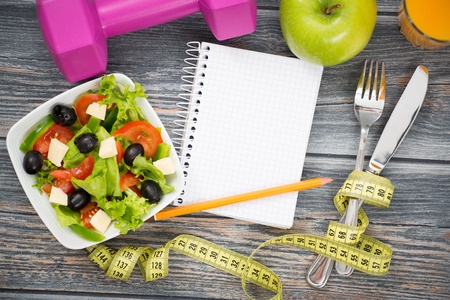

As fitness professionals, our job is to help our clients achieve results. A large part of their success depends on their nutrition and although prescribing specific meal plans may not be in the scope of our practice, getting our clients in the habit of journaling their food intake is something we can all do to help our clients achieve positive outcomes.
A food journal can take many different forms and can be reviewed in a variety of ways. It is important to find which way works best for you and your clients.
Why Food Journaling Works
Awareness – One of the biggest misperceptions people have regarding their inability to lose weight is they underestimate how many calories they eat and overestimate how many calories they burn. Food journaling is a great way to show them exactly how many calories they are consuming during the course of the day. (In order to determine how many calories your clients are burning check out this article on BMR)
Oftentimes, when first starting a journal our clients will be shocked to learn how much they are actually eating and by simply adjusting the quantity of food they eat it will be easier for them to reach their goals.
Accountability – Another benefit of journaling is that it helps keep your clients accountable for what they are eating. There is a saying “if you bite it, write it” meaning if you eat something you need to write it in your journal. This helps prevent your clients from eating foods that they know are not in line with their dietary goals.
Knowing they have to put it in their journal will make them think twice about making poor choices.They will also know that their trainer will be reviewing their journal and they will be accountable not only to themselves but to you as well, for their nutritional choices.
Perception vs Reality – Often, people perceive their diets as being healthier than they are. I can’t tell you how many times I’ve asked clients how many fruits and vegetables they eat and they tell me they eat a lot. I then had them journal for a week and they barely get 3-4 servings a day.
Putting their food intake on paper allows them to see for themselves they are not eating enough fruits and vegetables. This also relates to the above section on awareness, they become more mindful of what they are actually eating and where they are falling short or eating too much. Some clients don’t think they eat a lot of sugar or processed carbs until we review the journal and discover that they make up a majority of their diets.
Types of Food Journals
The type of journal your clients use and how they log their food will be determined by their lifestyle, the type of client they are (in person vs online) and if they are old-school or tech-savvy. There are also many different factors and things that can be included in their food journals which we will discuss in the next section.
Written Journal – Some clients will prefer to write down their food in a notebook. This is one of the least efficient and more cumbersome ways of journaling because they will need to write down not only what they ate but how many grams of protein, fat, and carbs, as well as calories for each meal. This takes up a lot of time and requires your clients to research the nutrition facts of foods, as well as do the math. For clients that are not analytical, this will often lead to frustration and incomplete information. It is also not ideal for online clients since it is more challenging to review for trainers.
However, a written journal (even if they don’t write down all the nutrition info) is better than nothing. If this is the only way you can get your clients to journal, then, by all means, have them hand write it. This will still give you and your clients a general idea of their diet and will help you suggest some healthier alternatives.
Apps or Online Logging
Using an app or online food journal is the most convenient way to track your client’s nutrition. There are many great nutrition tracking apps and sites that will make it easier for you and your clients to review their nutrition. My favorite one is My Fitness Pal. These food journaling tools already have almost every food imaginable in their database so all your clients need to do is select the food and the serving size and the nutrition totals will be automatically populated for them. Most people always have their smartphones within reach, making these apps ideal.
Top Nutrition Tracking Apps
Technology has made tracking your nutrition easier and less complicated. Almost all of our clients have smartphones and these apps are some of the best for food journaling.
- MyFitnessPal – This app has been the standard go-to app for many trainers for a long time. It has one of the largest food databases and it’s easy and fast to enter foods. It also saves your most frequent foods for easy access. It connects with many different apps and devices to track progress and also has a built-in step counter.
- Rise Up – This app not only allows you to track your food but also who you were with, where you where, and how you felt while eating. This can help identify if your client was emotional-eating or eating socially rather than eating because they were hungry.
- See How You Eat – This app is a photo logging app where your client can take photos of their meals. This app does not track calories but is good for clients who are not analytical and don’t want to get bogged down with the numbers.
- Lose It – This app allows your clients to take photos of their foods, track calories and nutrition, set goals, see serving sizes, plan meals ahead of time, and track weight and body measurements.
How to Review Your Client’s Food Journal
There are many different ways you can review your client’s food journals with them. You can sit down with them one-on-one during their training session, after their session (if you have the time), over the phone, via skype, or even through email if they are a distance client. For my in-person clients, I prefer to sit down with them face-to-face and review their journal during the last 15 minutes of their training session once per week. As a trainer, our time is money and usually, we’ll have clients back-to-back so taking time after a session is not always an option.
The first thing I usually look at is their total number of calories for each day and see if it is in line with the targets that we set based on their BMR and activity levels. If they are consuming more calories than they are burning this is the first thing we will address. We’ll look at the types of food, their macronutrient ratios, and the portion sizes. Usually, the portion sizes are the easiest thing to modify. The serving sizes for foods has increased dramatically over the last 50 years and cutting down on portions is a quick and easy way to lose a few pounds.
Next, I’ll look at the quality of foods they are eating. While it is true from a weight loss standpoint that calories in vs. calories out is the biggest factor, weight is just one part of the equation– we want our clients to be healthy inside and out. It’s possible to lose weight eating 1,500 calories consisting of Twinkies if you’re burning 2,000 calories. Simply monitoring calories is not a sustainable long-term strategy for our clients.
If there are meals logged that are out of line with their goals we will dig deeper and discuss where they were, who they were with, and why they ate them. People will eat foods outside their nutrition plan for a variety of reasons such as being bored, depressed, anxious and at social events. Sometimes it’s hard to resist if everyone at work is eating birthday cake.
Once in a while, it is ok, but if our clients are going out to eat multiple times per week and eating things that are setting them back we need to address it and give them some strategies and options to make healthier choices. I’ve put together a series of nutrition handouts for all my clients and one of them has tips for staying on track while traveling and dining out.
Food Journaling Tips
- Make it as easy as possible for your clients to food journal. If it becomes a hassle or feels like a chore they are less likely to comply. Teach them how to use the app if they aren’t 100% sure on the ins and outs. This means we need to familiarize ourselves with the app we are recommending.
- Give your clients encouragement and send them a message every now and then congratulating them on their great food choices or simply congratulate them for staying consistent with tracking their food. There will almost always be something positive they’ve done, comment on it and take the opportunity to encourage them.
- Make sure they are honest and complete with their tracking. Sometimes, clients will be apprehensive to tell us that they unhealthy foods. Let them know that our job isn’t to judge them and we are here to help. In order to help them, we need them to be comfortable enough with us to be 100% honest.
Food journaling is an effective tool for helping our clients reach their overall health and nutrition goals. Even if we are not dietitians or legally permitted to prescribe nutrition plans, we can still help our clients to become aware of what they are eating through the use of journaling. If you find that your clients need additional help or specific meal plans reach out to a licensed dietitian in your area for additional assistance.






